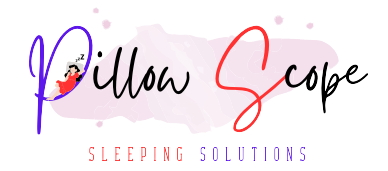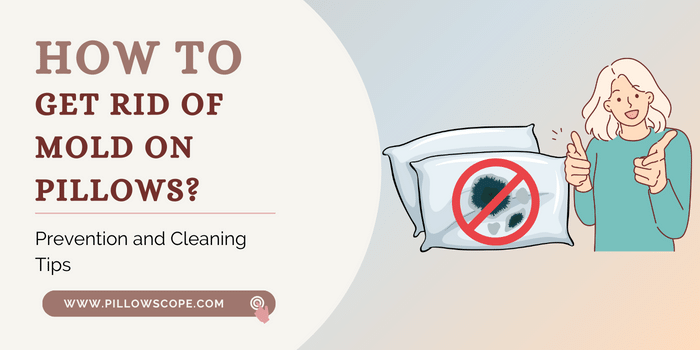Pillows are essential for a good night’s sleep, but when mold appears, it not only affects the pillow’s aesthetics but also poses potential health risks. Mold growth on pillows is expected, often stemming from factors such as high humidity, poor ventilation, and the body releasing natural oils and sweat when we sleep.
Mold development on pillows is not just an aesthetic concern; it may also cause significant health issues such as allergies and respiratory problems.
Identifying mold on pillows is the first step to resolving it. Discolored spots, a musty odor, and sometimes a fuzzy texture are all signs of this condition. Mold should be removed from your pillows immediately if you notice any of these signs. This article will teach you how to get rid of mold on pillows and maintain your pillows.
Table of Contents
Common Causes of Mold on Pillows
Excess moisture is one of the main reasons why mold grows on pillows. Pillows absorb moisture from our bodies and room air humidity over time. When moisture accumulates in cushions, it creates an environment conducive to mold growth. Addressing moisture issues is crucial to preventing mold. Inadequate airflow around pillows can lead to the development of mold. Proper ventilation and regularly putting pillows in the open air can minimize this risk.
Pillowcases collect sweat, dust, dead skin cells, and other debris, creating an environment conducive to mold growth. Regularly cleaning and replacing pillowcases can keep them fresh and mold-free. Neglecting pillow care, such as not fluffing or rotating them regularly, can contribute to mold problems. Regular maintenance is critical to preventing mold growth.
Visual Signs of Mold
Mold on pillows often manifests through discoloration, visible spots, and changes in texture. Keep an eye out for these signs to catch decay early on.
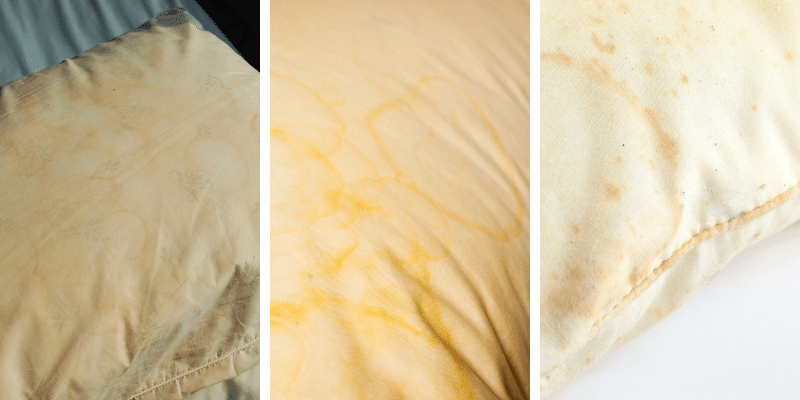
Discoloration and Spots:
Mold may cause dark or light discoloration on pillows, often appearing as spots or patches. These stains usually spread over time. Regularly inspecting these spots is vital for prompt action.
Unpleasant Odor:
A musty, unpleasant odor accompanies mold growth. If your pillow smells terrible, it’s time to investigate.
Texture Changes:
Mold-infested pillows may have a damp or slimy texture. Run your fingers along the surface to detect any unusual feelings. This tactile inspection can uncover hidden mold growth that might not be immediately visible.
Allergenic Reactions:
Mold exposure can trigger allergies. If you experience unexplained sneezing, itching, or congestion, your pillow could be the culprit.
Health Risks Associated with Mold on Pillows:
Mold spores released into the air can lead to respiratory issues. Individuals with asthma or allergies may experience exacerbated symptoms. Skin irritations can result from direct contact with moldy pillows.
Persistent itching or rashes may indicate that you should replace your pillow. Mold-infested pillows can cause problems with sleep. You may have difficulties staying asleep due to the discomfort caused by allergic responses. Prolonged exposure to mold on pillows may also contribute to headaches and fatigue.
Preventive Measures
Invest in waterproof and hypoallergenic pillow protectors. These covers create an additional barrier against moisture, preventing mold from taking hold. Open windows and use a fan to provide optimum ventilation. It aids in the reduction of humidity and the prevention of mold creation. Periodically inspect your pillows. If you notice discoloration or a musty odor, clean or replace the affected pillows as soon as possible.
Selecting Mold-Resistant Pillow Materials
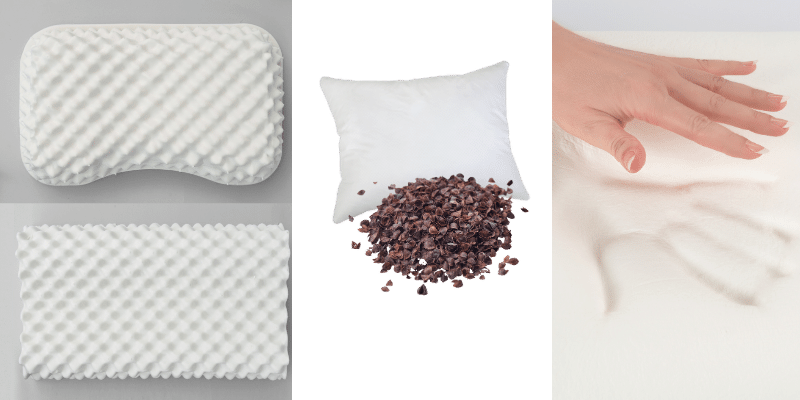
The type of pillow material plays a significant role in mold prevention. Mold and mildew are naturally resistant to latex pillows. Because the material is unfriendly to these fungi, it is a good solution for people who want to reduce the danger of mold on their pillows.
Buckwheat pillows have hulls that allow for good air circulation. Because of their natural flexibility, they are less susceptible to mold creation. Buckwheat pillows are also hypoallergenic, making them ideal for anyone with allergies.
Memory foam pillows, while not wholly mold-proof, but are less susceptible to mold than regular pillows. The dense nature of memory foam makes it more resistant to moisture absorption, reducing the likelihood of mold growth.
How to Get Rid of Mold on Pillows?
Addressing mold spots on pillows as soon as possible is critical to preventing future growth and maintaining a hygienic sleeping environment. Here are practical steps to take for quick action.
DIY Cleaning Solutions:
Vinegar Solution:
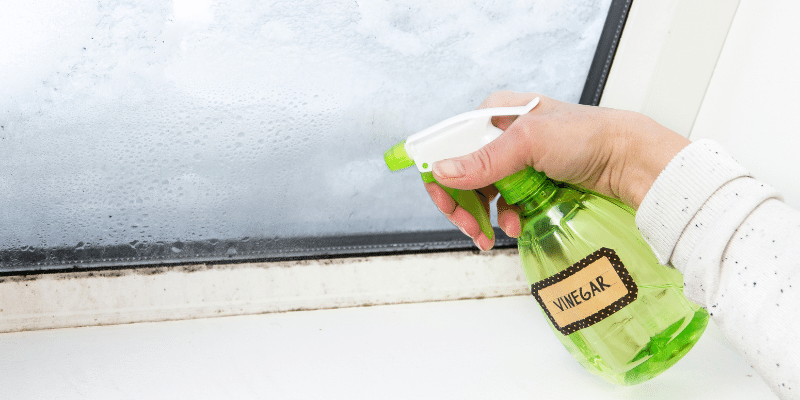
Create a DIY cleaning solution using white vinegar. Mix equal parts white vinegar and water in a spray bottle. Lightly mist the mold-affected pillow areas, allowing it to sit for 10–15 minutes. Gently scrub the stains with a soft brush or cloth. Finally, wash your pillow with hot water and dry it in sunlight properly.
Note: Before washing, read the manufacturer’s instructions.
Baking Soda Paste:

Make a paste by combining baking soda with a small amount of water. Apply the paste to the mold stains, gently scrubbing the affected areas. Let it sit for 15-20 minutes before wiping away the paste with a damp cloth. This natural solution helps eliminate mold stains and odors. Then, wash the pillow and follow the manufacturer’s instructions.
Lemon Juice and Salt Mixture:
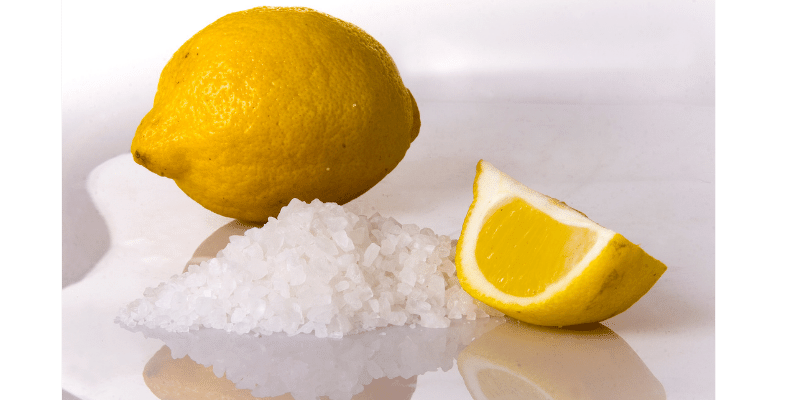
In the bowl, mix the lemon juice with table salt. For example, if you use one tablespoon of lemon juice, add half a tablespoon of salt. Stir the mixture well until the salt is fully dissolved. These create a powerful and mold-fighting paste. Apply the lemon juice and salt mixture to the mold stains on your pillow using a soft brush or cloth. Ensure an even application covering the entire affected area. Allow the mixture to sit on the cushion for 10–15 minutes.
This gives the lemon and salt time to penetrate the mold and break it down. After that, gently scrub the mold-stained areas with a soft brush or cloth. Once you’ve scoured the affected areas, rinse the pillow with clean water. Ensure that all the lemon juice and salt residues are washed away. Dry your pillow in direct sunlight. Inspect the pillow for any remaining residue. If necessary, rinse again and dry until no residue is left.
If DIY solutions prove insufficient, consider using commercial mold cleaners for fabric surfaces. Follow the product instructions carefully, and ensure the cleaner suits your pillow material. Test a small, inconspicuous area first to avoid any potential damage.
Proper Washing Techniques:
Before washing your pillows, always check the manufacturer’s instructions. Some pillows are machine washable, while others are non-washable and need spot cleaning.
When washing pillows, opt for a mild detergent. Harsh chemicals can break down fibers and impact the pillow’s integrity.
For machine-washable pillows, use a large-capacity machine to allow for proper cleaning. Wash two pillows at a time to maintain balance. Add a small amount of detergent, and run the device on a gentle cycle.
When washing pillows, adding a couple of clean tennis balls helps fluff them and prevents them from becoming lumpy during the wash.
After washing, opt for air-drying your pillows. Direct sunlight is a natural disinfectant and helps eliminate any remaining moisture. Ensure the pillows are completely dry before using them again.
If your pillows are not washable, spot cleaning is necessary. You can use a mild detergent or a mixture of water and white vinegar, a lemon juice and salt mixture, and baking soda paste for mold cleaning.
Replacing Old Pillows:
Evaluate the overall condition of your pillows. It may be time to consider replacing them if they are old, flattened, lumpy, worn, or showing signs of persistent mold despite cleaning efforts. Understand the lifespans of different pillow materials. Most pillows have a recommended lifespan of 1-2 years, after which they may lose shape and become more susceptible to mold.
Opt for hypoallergenic pillows, especially if mold has been a recurring issue. Materials like latex, memory foam, or buckwheat are less prone to mold growth and provide a healthier alternative. Establish a regular schedule for replacing pillows, even if no signs of mold exist. This proactive approach contributes to a cleaner and more refreshing sleep environment.
Seeking Professional Mold Remediation Services
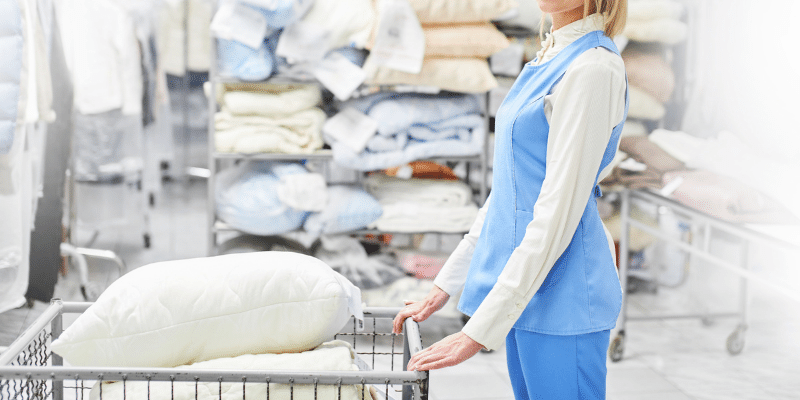
If mold issues persist despite your efforts, it’s crucial to assess the severity of the problem. Consider consulting with a professional mold remediation expert. These specialists have the knowledge and tools to determine the extent of the mold problem and implement effective remediation strategies. A professional inspection can identify hidden mold or moisture sources contributing to the problem. This step is vital for addressing the root cause of persistent mold issues.
Impact on Different Pillow Types
Mold can affect various pillow types differently, requiring tailored methods for prevention. Here are some mold-managing tips.
Mold-on Memory Foam Pillows:
Impact:
Memory foam pillows, known for their supportive and contouring properties, can be affected by mold. While memory foam is less susceptible due to its dense structure, prolonged exposure to moisture and a lack of proper ventilation can still lead to mold growth.
Prevention:
Ensure sufficient airflow around memory foam pillows. Using breathable pillowcases and maintaining good bedroom ventilation can help prevent mold. Invest in waterproof and hypoallergenic pillow protectors. These covers act as a barrier against moisture, reducing the risk of decay. Periodically check memory foam pillows for any signs of deterioration.
Management:
If mold appears on memory foam pillows, spot cleaning is effective. Use a mild detergent or a mixture of water and white vinegar to clean the affected areas.
Sunlight is a natural mold deterrent. Place memory foam pillows in direct sunlight to help eliminate moisture and inhibit mold growth.
Mold Prevention for Feather Pillows:
Impact:
Feather pillows, known for their softness and luxury, are more sensitive to mold due to their natural filling. Feathers can trap moisture, creating an environment conducive to mold growth.
Prevention:
Employ pillow protectors made of fabric to prevent moisture penetration.
Fluff feather pillows regularly to promote air circulation. This helps prevent moisture accumulation within the cushion.
Keep feather pillows dry. Avoid using them in damp environments; ensure thorough drying to prevent mold if they get wet.
Management:
Feather pillows may be machine washable (before reading the manufacturer’s instructions). Use a gentle cycle with a mild detergent. Ensure pillows are completely dry before use to prevent mold regrowth.
After washing, place feather pillows in direct sunlight to aid in drying and eliminate any remaining moisture.
Mold Management for Synthetic Pillows:
Impact:
Synthetic pillows, made from materials like polyester, are less prone to mold than natural options. However, they are not entirely immune, especially if exposed to persistent moisture.
Prevention:
Use pillow protectors to create a barrier against moisture. Ensure good airflow in the bedroom. Proper ventilation contributes to a drier sleep environment, reducing the risk of mold on synthetic pillows.
Management:
Follow the recommended washing instructions. Machine-washing synthetic pillows with a mild detergent can effectively remove mold and maintain cleanliness.
After washing, air-dry synthetic pillows thoroughly. Ensure they are completely dry before use to prevent mold regrowth.
Conclusion:
In conclusion, maintaining a mold-free sleep environment is essential for overall well-being. By following the outlined preventive measures and effective cleaning solutions, you can enjoy a healthier and more restful sleep. Remember, a little effort in pillow care goes a long way.
FAQs.
How often should I replace my pillows to prevent mold growth?
Regular replacement every 1-2 years is advisable to minimize the risk of mold.
Can mold on pillows cause allergies?
Yes, mold on pillows can trigger allergies and respiratory issues.
Are there specific pillow types that are less prone to mold?
Mold-resistant pillows, like memory foam and latex, are less susceptible.
Do pillow protectors effectively prevent mold?
Yes, pillow protectors act as a barrier against moisture, reducing the risk of mold.
Is professional mold removal necessary for every case of mold on pillows?
Professional assistance is recommended for severe mold infestations to ensure thorough removal.
